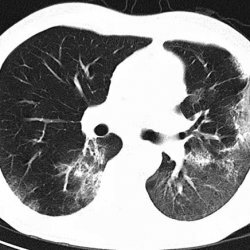Emergency help for pulmonary hemorrhage
 If pure blood is isolated during the cough or in the form of an impurity to the sputum, then we can talk about pulmonary hemorrhage. This is a very serious and rather dangerous inflammatory complication of nonspecific and specific diseases of the respiratory system, damage to the lungs and malignant tumors.
If pure blood is isolated during the cough or in the form of an impurity to the sputum, then we can talk about pulmonary hemorrhage. This is a very serious and rather dangerous inflammatory complication of nonspecific and specific diseases of the respiratory system, damage to the lungs and malignant tumors. Bleeding begins during the disintegration of lung tissue, when the vessels do not have time to be thrombosed. The cause may be a foreign body, located in the trachea or bronchi, which damages the vessel.
The volume of bleeding is classified into small( less than 100 ml of blood), moderate( up to 500 ml of blood), profuse( from 500 ml).Bleeding starts suddenly or after a long hemoptysis. The blood has a light red color. If the blood is delayed in the lungs for some reason, it will be a dark brown color with clots. But in this case the blood can foam.
Cough is not accompanied by blood escaping from the esophagus. Minor blood loss is tolerated by adults usually easily. But to children and people of advanced age, blood loss can disrupt the vital activity of the body.
Help with bleeding
If there was a bleeding, then the sick person should be put on his back, lifting his head slightly. This is required in order that the blood can not get into a healthy lung. Create the conditions for free breathing a person: unfasten clothes, remove dentures. Put a container with ice on the affected part of the chest. Invite the patient to swallow a few small pieces of ice. This will lead to reflex spasm. Easy to fill with blood will not.
If the bleeding is profuse or the patient has lost consciousness, then it needs to be laid on its side. You can not eat and drink. Find out, if possible, what drugs were taken, than the person was sick. This information will be required by health professionals.
Cough suppress the patient should not. Moreover, the path clears throat. It is not necessary to give a value to the volume of blood released during a cough.
Treatment of bleeding is concluded in its rapid stop and the completion of blood loss. For this, haemostatic drugs are prescribed. With significant bleeding, even before hospitalization, a drip intravenous infusion should be made. You can use aminocaproic acid.
In case of heavy bleeding, you should put on the legs and put on the tourniquets. Pull the hips and shoulders with rubber bandages. If there are no bandages, then cuffs from tonometers are suitable for tugging. It takes a lot of pulling to stop the outflow of venous blood. But the pulse should be preserved on the arteries of the lower legs, as well as the forearms.
Calcium chloride is able to stabilize the cell walls of blood vessels. This will prevent diapedesis( impregnation) of blood flow through the walls of the vessels. Restore the volume of circulating blood can be any physiological solution. Usually, sodium chloride( 0.9%) is used. But modern drugs are considered more effective, which can prevent a threat or an already started shock with severe blood loss. These funds include gelofusin and venofundin.
It is necessary to control blood pressure. Elevated blood pressure increases bleeding. Low blood pressure provokes a hemorrhagic shock. This is a serious complication in bleeding. It is necessary to forbid the sick person to talk and move.
Find out the cause of pulmonary hemorrhage is very important. This will allow you to choose the right treatment tactics. To influence the disease that provoked bleeding is much more important than simply stopping the bleeding.
After providing prehospital care, the patient must be sent to a medical institution.



